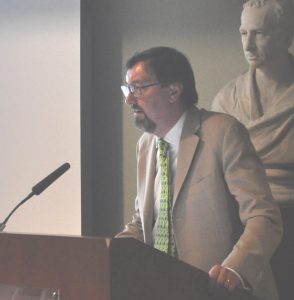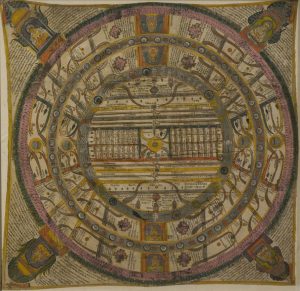Marwar – Architecture and Presentation of the Universe
On Friday 7th April, the RAS welcomed Dr Giles Tillotson, Dean of the Sushant School of Liberal Arts, Ansal University, to lecture on the Architecture and Landscape in Marwar. Dr Tillotson spoke to a large and engaged audience on the weaving of western and eastern influences; how Art Deco mixed with traditional Indiam styles, particularly in the interior decoration of the buildings of the area. His lecture was wonderfully illustrated through the use of some beautiful slides. We are grateful to Dr Tillotson for providing such a vivid picture of this region of North Western India which includes the present-day districts of Barmer, Jalore, Jodhpur, Nagaur, and Pali.

A lecture on a particular area always encourages me to look within our Collections for items related to that region.

The above illustration is of Jambudvipa, a cosmological representation of the universe. This map has at its centre Mount Meru, the sacred mountain with five peaks which in Hindu, Jain and Buddhist cosmology is considered to be the centre of all the physical, metaphysical and spiritual universes. Concentric rings denote the oceans and mountains surrounding the mountain. This particular version is believed to be by a Marwar artist, dating to around 1817. It is inscribed in Gujarati with descriptions mentioning the natural objects and features to be found on the continent of Jambudvipa.
It also has an English inscription which states: “Written by Tilokcand and Dayacand the eminent pundits, disciples of Rupadhira Gani, the disciples of Kusalabakta Gani, in the Brhat-Kharatana Gaccha and in the branch thereof named after Jinacandra Suri; in the Samvat year 1873, in the Saka year 1739, on the 7th (or 3rd) day of the light fortnight in the month Jyasaitha. It is the book of the eminent pundit Pasadetta; it was written for his private study. 23 (or 19) May 1817.
The Jambudvipa was donated to the RAS by Major-General William Miles in 1837 and the Society’s donation register suggests that it was given to Miles by “a Jain priest of the Province of Marwar”. In the Journal of the RAS for 1916, F.E. Pargiter, the civil servant and orientalist, undertook a description of the “Map of the Earth”. Pargiter served in India from 1875 to 1906 becoming Under-Secretary to the Government of Bengal in 1885, District and Sessions Court judge in 1887 and a judge of the Calcutta High Court in 1904. Pargiter voluntarily retired in 1906 following the death of his wife and returned to the England. In 1916, when the article was written, it seems that it was unknown how the map came to be part of the Society’s Collections so we have to be grateful to Raymond Head, in collating the catalogue of the RAS paintings, drawings, engravings and busts, for discovering the original donor within the Society’s early registers.
Pargiter describes the map: “In the centre is Mt. Meru, depicted as a yellow circle with a silver-grey portion, and the name Meruparvat written on it. If the map be placed with this name uppermost, it will be in the right position, the top being north, the bottom south, and so on.
“Outside Meru and with a diameter of 12 1/2 inches, is a large circular belt or ring (silver-grey), which denotes the Salt Ocean, and all the country within this ring is the continent Jambu-dvipa, of which Meru is the centre. Jambu-dvipa is shown as divided into five portions, a square compartment in the middle, two large segments north and south of that, and two chequer-shaped compartments east and west of that. In the middle compartment are four horn-shaped mountains in the corners, namely, N.E. Malyavant, N.W. Gandhamadana, S.W. Vidyutprabha and S.E. Somanasa. South of Meru are placed the great Jambu tree and Deva-kuru-ksetra; and north of it are the great salmali (silk-cotton) tree and the Northern Kurus….”
And so his article continues to give a rich description of the painting. For those of you who are interested, a copy of the article may be found on the shelves in the Reading Room, and perhaps more importantly, the Jambudvipa is hang on the rear wall of the Reading Room. So please take the opportunity to come and see it, and learn more of this wonderful item in our Collections.
And with that comment concerning visiting the RAS, please note that we will be closed for the Easter period from Thursday 13th April until Monday 17th April inclusive. We will reopen on Tuesday 18th April when we hope that you will be able to join us for another lecture. Dr Martin Bayly (London School of Economics) will lecture on “Taming the Imperial Imagination: The Genesis of Colonial knowledge on Afghanistan, 1808-1878”. We hope that many of you will be able to join us on this occasion – and do take the opportunity to see the Jambudvipa as well.
